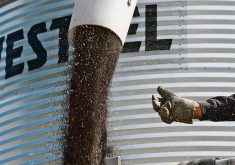Spring is considered to be a good time for farmers to take a fresh look at potential hazards before things get too busy
Just as some people clean their houses from top to bottom each spring, producers must closely examine their farms and ranches for safety hazards at this time of year, says a national advocate.
“Everybody gets complacent, right?” said Robin Anderson, communications co-ordinator for the Canadian Agricultural Safety Association (CASA).
“It doesn’t matter who you are, where you are, or where you work … and safety folks aren’t here to judge or point fingers, or anything like that. All we want at the end of the day is for farms, for families (and) farming communities to be healthy and safe and sustainable, so that’s what we’re there for….”
Read Also

Fuel rebate rule change will affect taxes and AgriStability
The federal government recently announced updates to the fuel rebates that farmers have been receiving since 2019-20.
Due to the fact farm machinery has been sitting idle over the winter, spring is a good time to take a fresh look at potential hazards before things get too busy, she said. A report on agriculture-related fatalities released by CASA in 2016 detailed why such actions are necessary.
There were 843 agriculture-related fatalities in Canada from 2003 to 2012, or an average of 84 per year, it said.
“When compared with other Canadian industrial sectors, agriculture is a dangerous occupation.”
Machine runovers, rollovers, and being pinned or struck by a machine component were the top three ways deaths occurred during that period.
“Seasonally, machine rollovers were the leading causes during the two most active seasons, summer and fall. It was the second leading cause in the spring.”
The report said occupational injuries in other industries usually involve workers ages 18 to 65.
“Agriculture is unique in that children and the elderly sustain significant numbers of severe work-related injuries.”
As someone who grew up on a farm, Anderson said such statistics aren’t simply a bunch of impersonal numbers for most producers.
“My dad lost part of his finger, my brother fell off a combine and was badly cut, my sister was in a snowmobile crash … my great aunt, her first husband was killed. He was run over by a set of harrows, so it doesn’t take all that much to think about that and really, truly have that personal connection.”
One way for producers to improve safety is to do a walkabout tour each spring involving everything from checking that fire extinguishers are charged, and first-aid kits are ready to go, to making sure machinery is in good shape.
“It could be going through your shop and being like, ‘oh yeah, there’s some tripping hazards here. Oh, you know what, I did some work and I didn’t put the guard back on this tool or this piece of equipment.’ You know, doing a full circle of the yard and being like, ‘oh, yeah, you know what, I’ve got this baler twine. You need to clean that up.’”
For producers who don’t know where to start, organizations such as CASA are available for advice, said Anderson. It offers the Canada FarmSafe Plan, which is available online for private use at no cost.
The plan contains everything from step-by-step guides and checklists to sample polices to help producers create a safety program. Anderson said mental health is another aspect of safety that shouldn’t be overlooked as farmers begin to head into their busiest and most stressful time of year.
Impacts on mental health can cause them to make bad decisions as well as affect sleep and relationships, which in turn can impact how they behave in dangerous situations.
“It’s not just about your physical safety, your physical body, it’s also about mental health and mental safety.”
For more information, visit casa-acsa.ca.
















